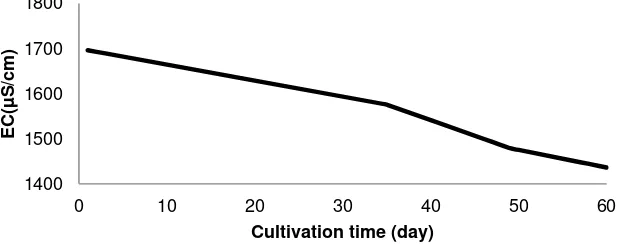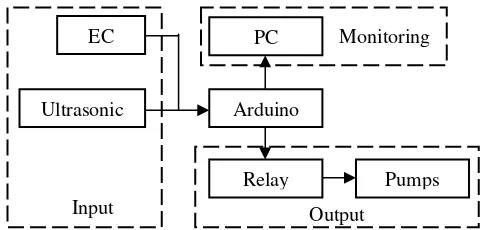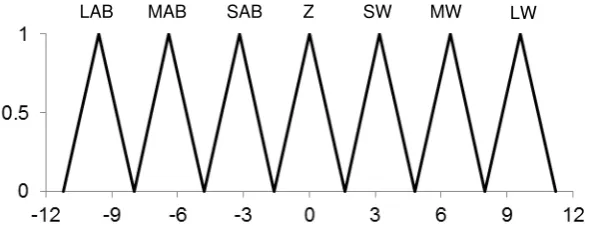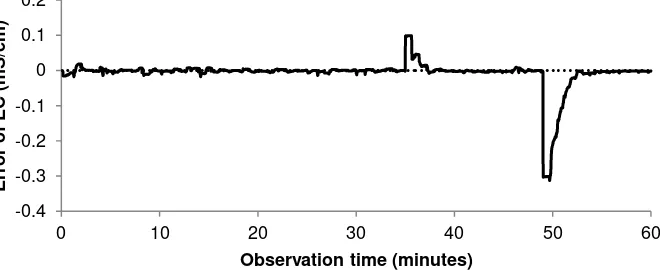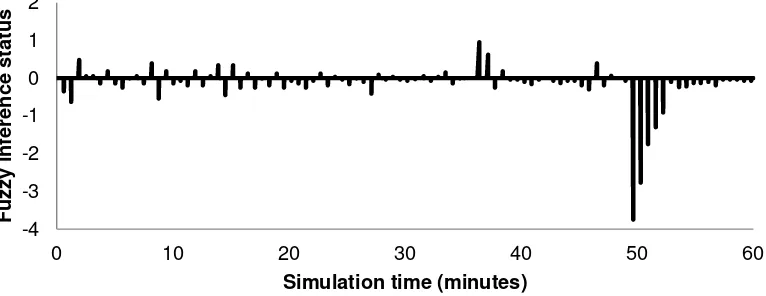DOI: 10.12928/TELKOMNIKA.v13i4.2113 1281
Control System for Nutrient Solution of Nutrient Film
Technique Using Fuzzy Logic
Muhammad Naufal Rauf Ibrahim*, Mohamad Solahudin, Slamet Widodo
Department of Mechanical and Biosystem Engineering, Bogor Agricultural University, Jl. Raya Darmaga Kampus IPB Darmaga Bogor 16680, West Java, Indonesia
*Corresponding author, e-mail: [email protected]
Abstract
Nutrient Film Technique (NFT) is one of the hydroponic systems, which the nutrient is circulated through root of the plants. Electrical conductivity (EC) of nutrient solution on hydroponic culture is a crucial point that determines the growth rate of the plants and quality of the products. The purpose of this research is to design the control system for nutrient solution to maintain the EC of nutrient solution using Arduino.Fuzzy logic control system was used with EC error and volume of nutrient solution as inputs. Model of tomato cultivation based on certain reference was simulated with scale 1:1440 for cultivation time. This model was used as disturbance of nutrient solution EC due nutrient uptake. The result of observation showed that system could reach setpoint after 130 seconds when the setpoint changes from 1.7 mS/cm to 1.6 mS/cm and 207 seconds from 1.6 mS/cm to 1.9 mS/cm. During observation, RSME value of the system while steady state was 0.005 mS/cm.
Keywords: EC, fuzzy, simulation, control system
Copyright © 2015 Universitas Ahmad Dahlan. All rights reserved.
1. Introduction
Nowadays hydroponic crop production has significantly increased in recent years worldwide, as itallows a more efficient use of water and fertilizers, as well as a better control of climateandpest factors [1]. Total ionic concentration of a nutrient solution determines the growth, development andproduction of plants [2]. Electrical conductivity (EC) of nutrient solution in hydroponics can represents the total amount of salt in the nutrient solution which is also a indicator of the amount of ions to the plants [3]. The ideal EC is specific for each crop and dependent on environmental conditions [4], which higher EC hinders nutrient uptake by increasing osmotic pressure andlower EC may severely affect plant health and yield [5]. Therefore, management of EC solution in hydroponic is certainly necessary in order to keep the high yield of production while preventing the excessive use of nutrient solution. Propermanagement of EC of the nutrient solution can provide and effective tool to improve vegetable quality [6]. In this research, management of EC solution in NFT system by using control system is proposed.
There are several reports and papers about effort to manage the important parameter of hydroponics including EC by using automatic control system. With the same type of hydroponics, Delya [7] reported chili pepper that is cultivated by automatic control of water content for plant medium has better result than cultivated by human control, using the simple ON-OFF method in real condition. Similar previous research is also reported by Suprijadi [8], which the control system is using volume as input parameter and PWM value as output parameter with fuzzy logic as control mechanics. In the other hand, Domingues [9] developed automated system control for hydroponic with combined parameter by EC, temperature, pH of nutrient solution.
system could control EC in accelerated cultivation time, then the system also can control EC in the real time.
Fuzzy logic controller application to improve the system performance has shown the significant result. Fuzzy logic based direct torque control system was implemented in induction motor and had improvement in reducing torque ripples, faster torque response, stability at very low speed compared to conventional direct torque technology [10]. Prayitno [11] developed autonomous flight task for quadcopter to replace manual control by human and capable to following the flight task instruction. Previous study by Prathistaya [12] set the accelerated cultivation time to 90 days to 2 days and using PID control. This paper also observed and compared the performance of the system if the cultivation time is set by faster and using fuzzy logic controller
2. Research Method
In this paper, control system of nutrient solution was built based on nutrient uptake of tomato. There are several works about nutrient uptake and EC setpoints of nutrient solution in hydroponics especially nutrient film technique, one of them is the reports about nutrient uptake of tomato on nutrient film technique [13]. This paper explained the nutrient uptake of tomato during 63 days of tomato cultivation separately by each ion in the nutrient solution and one of them is Nitrate or NO3
-. Nutrient solution called AB mix which is two separate nutrient stocks solution namely stock solution of A and B [14]. Using ion uptake information and contained ion in AB mix, model of nutrient uptake by certain ion can be set.
Based on the model of nutrient uptake, control system was built with consideration of the system can control the EC or not while nutrient uptake is occurred. Control system is tested by simulation with shortened cultivation and initial nutrient volume. Nutrient uptake on cultivation results declination of EC value which can be represented by adding water to nutrient tank or called EC disturbance. With this, control system can be evaluated by observing its capability to control EC of nutrient solution.
2.1. EC Disturbance
EC disturbance will be applied by adding water to the nutrient solution and mimics the EC declining due to nutrient uptake during 60 days of tomato cultivation. The nutrient uptake rate is applied based on the previous research [13]. Based on the reference [13], model of tomato cultivation is set. The set model has a tomato plant with initial nutrient solution 200 liters. This model used ion uptake NO3
as nutrient uptake and interpret it to EC value. Figure 1 shows the EC declining rate of tomato cultivation due nutrient uptake.
Figure 1. Model of EC decling rate of tomato cultivation due nutrient uptake
Thus, this model of EC declining rate of tomato cultivation was simulated with scale 1:1440 (from 60 days to 60 minutes) for cultivation time and 1:25 (4 liters to 100 liters) for intial nutrient volume. An automated pump was used to mimics the EC declining rate at the
Figure 2. EC setpoint on tomatocultivation
2.2. Control System Hardware
Control system for this nutrient solution of NFT used Arduino microcontroller and 2 sensors. The sensors is consisted of EC sensor Atlas Scientific K1.0 to measure the EC value of nutrient solution and ultrasonic sensor HC-SR04 to measure the height of nutrient solution, which later converter into volume in calculations.
For output signal, Arduino is connected to a four channels relay to control the actuator. The control system hardware is shown by Figure 3.
Figure 3. Hardware of control system
Four AC pumps that used as actuators are two nutrient pumps (for A and B nutrient), a water pump and disturbance pump. The nutrient pumps and water pump are used for control purpose while the disturbance pump is used for representing the EC declining rate due to nutrient uptake by adding the water. Figure 4 shows schematic diagram of control system.
Figure 4. Schematic diagram of control system 1.5
1.6 1.7 1.8 1.9 2
0 1 2 3 4 5 6 7 8 9
EC Setpoint (mS/cm)
nthWeek
EC
Ultrasonic Arduino
Relay PC
Pumps
Input Output
2.3. Fuzzy Logic Controller
The designed fuzzy logic controller has two input variables and one output variable. The input variables are error of EC (EEC) and volume of nutrient solution (V).Error of EC is acquired by difference between EC setpoint (ECs) and actual EC (ECa). Volume ofnutrient solution is acquired by height of nutrient solution (h) times area of nutrient solution tank (A).The formulas are:
EEC = ECa ECs (1)
V = A * h (2)
Range of membership functionfor error of EC and volume of nutrient solutionare [-0.4, +0.4] mS/cm and [3.5, 9.5] liters. Maximum capacity of nutrient solution tank on simulation is 10 liters.
The output variable is pump activation time with membership function range [-11.8 +11.8] seconds. All fuzzy membership is set by trial and error. Figure 5, 6, and 7 shows membership function error of EC and volume of nutrient solution.
Figure 5. Membership function of error of EC
Figure 6. Membership function of volume
E M F
Figure 7. Membership function of pump activation time
The implication rules that used in fuzzy rules are IF error EC ‘x mS/cm’ AND volume ‘y liters’ THEN pump activation ‘z seconds’ with Mamdani inference. Appropriate pump activation time is expected to be the output that can maintain the EC of nutrient solution. Fuzzy rule base for pump activation time is shown by Table 1.
Table 1. Fuzzy rule base for control system
Fuzzy Rule Volume of Nutrient Solution (liter)
E M F
Error of EC (mS/cm)
LN SAB MAB LAB N SAB SAB MAB Z Z Z Z P SW SW MW LP SW MW LW
Defuzzification is carried out by using center of gravity method [15] for determining the crisp value of pump activation time in seconds. Center of gravity (Z) can be calculated by:
Z
=∑
∑
(3)Data acquisition by both EC and ultrasonic sensors are processed per second during simulation, while fuzzy logic calculation and pump activation are processed per 35th sensor reading. This is due to the EC sensor hardware, which is stable after 15-25th sensor reading and also mixing process until nutrient solution is uniform enough.
3. Results and Discussion
3.1. EC Profile During Observation
Control system is tested and observed during 60 minutes with 3 different setpoints. Control mechanismthat used on system is pump ON-OFF control with pump activation time is based on fuzzy inference. Figure 12 shows EC profile of nutrient solution during control.
Figure 9. EC profile of nutrient solution during control
Based on Figure 12, the system can maintain the EC during steady state condition and control the EC of nutrient solution to the setpoint when the setpoints change. Though the system can maintain the EC, overshoot and undershoot is still occurred during control. This is due to the system used ON-OFF control mechanism, as the one of characteristic of ON-OFF control mechanism is occurring overshoot and undershoot during control [16]. Figure 13 shows error value during control.
Figure 10. Error of EC value during control
Two errors at 35th and 50th minutes are control system lag when setpoint changes is occurred. Based on Figure 13, the system can reach the setpoint within 130 seconds when setpoint changes from 1.7 mS/cm to 1.6 mS/cm and 207 seconds when setpoint changes from 1.6 mS/cm to 1.9 mS/cm. During steady state condition, the highest positive error is 0.02 mS/cm and highest negative error is -0.018 mS/cm. RSME value of the system control is 0.005 mS/cm during the steady state.
By evaluation of the performance in the control system, this control system had lesser error compared to the previous work by Prathisthaya [12], which the control system had RSME 0.023 mS/cm. This also means even with faster accelerated cultivation time, fuzzy logic controller was able to be more accurate than PID control mechanism. Wider range of setpoint and faster response compared to Domingues [9], allow the system to be applicable in other commodity of hydroponics. The lesser error also allows the system to save the more nutrient up
1.4 1.5 1.6 1.7 1.8 1.9 2
0 10 20 30 40 50 60
EC (mS/cm)
Observation time (minutes)
Reference Controlled Uncontrolled
-0.4 -0.3 -0.2 -0.1 0 0.1 0.2
0 10 20 30 40 50 60
Error
of EC (mS/cm)
3.2. Scaling up to Real Dimension of Control System
Though the simulation is an accelerated cultivation time (from 60 days to 60 minutes), the control system manage to maintain and control EC of nutrient solution. With acceptable error in result, the system is supposed to be applicable in real situation. Real situation of the model has 60 days of cultivation and 100 liters of nutrient tank capacity. In order to tune the control system in simulation to control system for real situation, scale up is set. Scaling up can be done by modifying fuzzy membership of pump activation time or flow rate of pump.
However, modifying those parameters arbitrary can result an undesirable impact on the control system. Modifying only fuzzy membership of pump activation time result in long settling time when setpoint is changed, but this modification has stable nutrient solution mixing process and lesser noises while control. In the other hand, modifying only flow rate of pump cause unstable nutrient solution mixing processes though it has faster settling time. This problem will cause unnecessary addition of water or nutrient solution in control process. It also occured in the simulation, described by fuzzy inference of pump activation while control. Figure 11 shows the fuzzy inference status.
Figure 11. Fuzzy inference status during control system
During the steady state condition, the nutrient pump is expected to be the only pump that opened because the disturbance is only EC decline due water addition. Sensor reading during incomplete mixing process could give an inaccurate either nutrient or water addition to achieve the setpoint, and undesired waste of nutrient usage.
Considering the real application, Prastaya [17] reported at the red spinach cultivation in hydroponic farm of Joy Farm in Indonesia, there is an occurrence that within an hour EC value of nutrient solution drop by 0.1 mS/cm. Based on Figure 9, the control system can manage to control the difference of 0.1 mS/cm by 130 second. From this situation, it is safe to change only the fuzzy memberships which result in longer settling time but stable mixing process and precise fuzzy decision. New fuzzy membership for pump activation time can be set by calculates the fuzzy membership times 25. Though so, a faster settling time and less noise setting is still possible to set if certain model of nutrient solution mixing process is known.
4. Conclusion
Control system of nutrient solution is built by using Arduino integrated with fuzzy logic controller. Model of tomato cultivation based on certain reference from the previous research was simulated with scale 1:1440 from 60 days to 60 minutes of cultivation time. Setpoints that set for control are 1.7 mS/cm, 1.6 mS/cm, and 1.9 mS/cm. Actuator is controlled by ON-OFF mechanism with time activation is decided by fuzzy logic controller.
Based on EC value during simulation, system can reach the desired setpoint within 130 seconds when setpoint changes from 1.7 mS/cm to 1.6 mS/cm and 207 seconds when setpoint changes from 1.6 mS/cm to 1.9 mS/cm. Duringsteady state condition, the highest positive error
is 0.02 mS/cm and highest negative error is -0.018 mS/cm. RSME value of during control while in steady state is 0.005 mS/cm. Overall, the control system can maintain and control EC of nutrient solution based on decided setpoints. Compared to PID control mechanism, fuzzy control had less error.
In order to apply this control system for real application, scale up is set. Set scale up is based on ratio of model and simulation initial nutrient solution. Two parameters that can be scaled up is fuzzy membership of pump activation time and flow rate of pump. Modifying only fuzzy membership of pump activation time result in long settling time when setpoint is changed but it has stable nutrient solution mixing process and lesser noises while control. Modifying only flow rate of pump cause unstable nutrient solution mixing processes but it has faster settling time. Based on real problem, it is suggested that changing fuzzy membership of pump activation time is safe in order to achieve precise fuzzy decision and lesser noise while control. In future studies, more element of nutrient solution ion uptake should be included in simulation to make the system more accurate according to the actual nutrient uptake of the plant.
References
[1] Trejo Téllez LI, Gómez-Merino FC. Editors. Nutrient Solutions for Hydroponic Systems, Hydroponics – A Standard Methodology for Plant Biological Researches. Rijeka: Croatia. 2012.
[2] Steiner AA. A Universal Method for Preparing Nutrient Solutions of a Certain Desired Composition. Plant and Soil. 1961; 15(2): 134-154.
[3] Nemali KS, Van Iersel MW. Light Intensity and Fertilizer Concentration: I. Estimating Optimal Fertilizer Concentration from Water-Use Efficiency of Wax Begonia. Hort Science. 2004; 39(6): 1287-1292.
[4] Sonneveld C, Voogt W. Plant Nutrition of Greenhouse Crops. New York: Springer.2009.
[5] Samarakoon UC, Weerasinghe PA, Weerakkody AP. Effect of Electrical Conductivity [EC] of the Nutrient Solution on Nutrient Uptake, Growth and Yield of Leaf Lettuce (Lactuca sativa L.) in Stationary Culture. Tropical Agricultural Research. 2006; 18(1): 13-21.
[6] Gruda N. Do Soilles Culture Systems have an Influence on Product Quality of Vegetables? Journal of Applied Botany and Food Quality. 2009; 82(2): 141-147.
[7] Delya, Buti. Design of Ebb and Flow Automatic Hydroponic System for Chilli Pepper Cultivation. Jurnal Teknik Pertanian. 2015; 3(3).
[8] Suprijadi, Nuraini N, Yusuf M. Sistem kontrol nutrisi hidroponik dengan menggunakan logika fuzzy. Jurnal Otomasi, Kontrol, dan Instrumentasi. 2009; 1(1):31-35.
[9] Domingues DS, Camara CAP Nixdorf SL, Takahashi HW. Automated system developed to control pH and concentration of nutrient solution evaluated in hydroponic lettuce production. Computers and Electronics in Agriculture. 2012; 84: 53–61
[10] Ming D, Bing-jie W, Hailing S, Yong-qi T. Study of an Improved Fuzzy Direct Torque Control of Induction Motor. TELKOMNIKA. 2013; 11(4): 691-698.
[11] Prayitno A, Indrawati V, Utomo G. Trajectory Tracking of AR. Drone Quadrotor Using Fuzzy Logic Controller. TELKOMNIKA. 2014; 12(4): 819-828.
[12] Prathisthaya, ME, Liyantono, Solahudin M. Rancang Bangun Sistem Kendali Proportional Integral-Deritative pada Pengendalian Konsentrasi Larutan Nutrisi Hidroponik. Proceedings of the National Seminar FTIP UNPAD – PERTETA – HIPI 2014. Jatinangor. 2014: 376-384
[13] Weerakkody WAP, Wakui K, Nukaya A. Plant nutrient uptake in recirculation culture of tomato under growth stage based electrical conductivity adjustment. Journal of National Science of Sri Lanka. 2011; 39(2):139-147.
[14] Dermawati. Substitusi hara mineral organik terhadap inorganik untuk produksi tanaman pakchoy (Brassica rapa L.) secara hidroponik. Thesis. Bogor: Postgraduate IPB. 2006.
[15] Kusumadewi S, Purnomo H. Aplikasi Logika Fuzzy untuk Pendukung Keputusan. Yogyakarta: Graha Ilmu. 2004.
[16] Siegenthaler J. Modern Hydronic Heating: For Residential and Light Commercial Buildings. New York: Cengage Learning. 2011:335.
